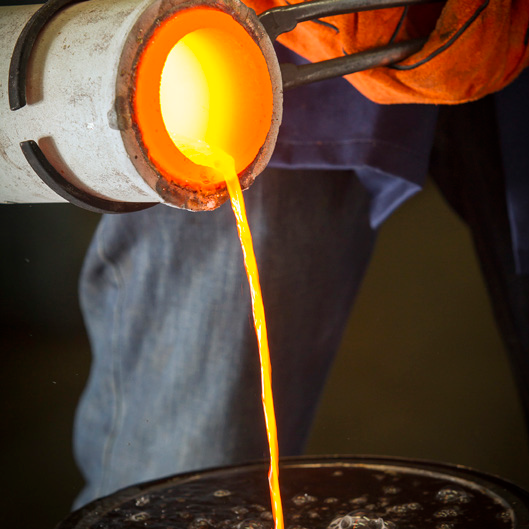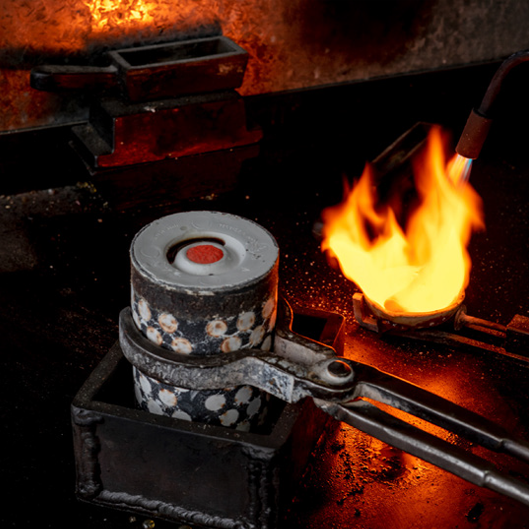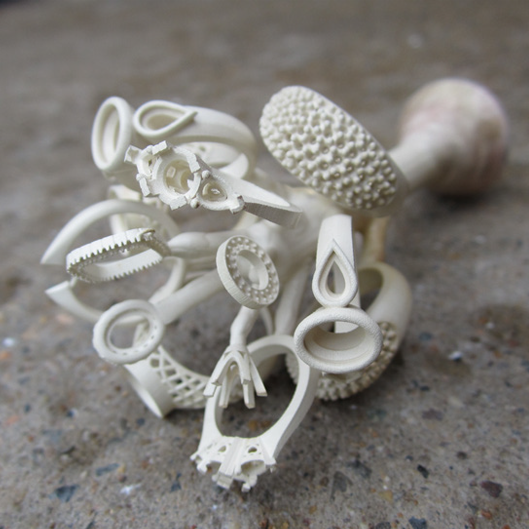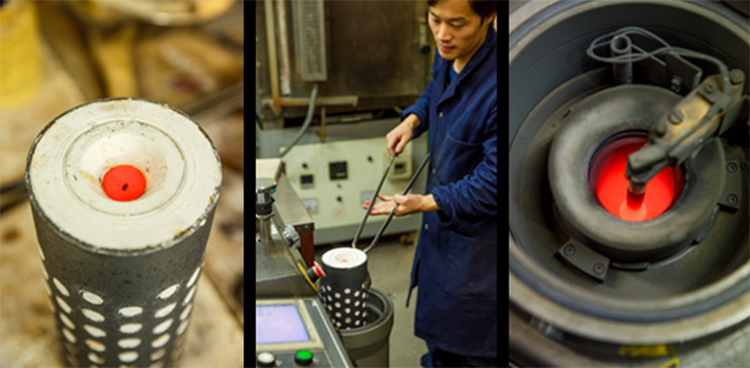When it comes to casting and refining, technology is at the forefront. When Jeweller last reviewed the category 2017, the breakthroughs were focused on precious metal chemistry and new alloys, as well as the rise of 3D printing and CAD/CAM, induction melt pressure casting and acid-less separation (ALS).
Today, the same themes are carrying through, with an added emphasis on faster, more efficient and – notably – more environmentally conscious processes.
Chris Botha, operations manager jewellery division at Pallion, which is the parent company of custom jewellery manufacturing business Palloys, points to the use of “environmentally friendly precious metal that is responsibly sourced from guaranteed conflict-free areas”.
In terms of technology, he cites Pallion’s use of ALS to refine precious metals, calling it “the most technologically advanced, environmentally-sound, non-toxic refining separation process that exists today”.
Chemgold is equally committed to the environment. As well as utilising all available recycling techniques, the company has imported state-of-the-art furnaces from Japan and Germany, which then feed into a non-pollution exhaust system equipped with an advanced after-burner.
New technologies surrounding ‘green’ or eco-friendly manufacturing processes is a major focus of local suppliers, with all making major investments in this area.
The benefits of these improved processes – as well as steps like preventing packaging waste with biodegradable options, and reducing energy through solar power and more efficient machinery – are not only good for the planet, they also make economic sense.
Cast, present and future
There are two major developments in the casting sector. By far the biggest has been the increasing prominence of 3D printing, and by extension CAD/CAM. The major driver has been the significant fall in cost, leading manufacturing jewellers to embrace them as part of the production process.
Ben Farago, production manager Rapid Casting, says, “We have gone from jewellers staring wide-eyed at the mention of 3D printing to it being common to have a low cost 3D printer in relatively small workshops,” adding that it’s now a prevalent and sustainable part of the jewellery trade. “We have seen jewellers go from seeing 3D printing as almost a threat and something they needed to compete with, to being widely accepted.”
“Previously I predicted the cost of 3D printers would be below $1,000 within ten years – it happened in seven,” says Botha.
This presents a marked change from previous years and while some anticipated it would have a negative impact on printing volumes for casting houses, the opposite has proved true. The process of jewellery manufacture is now more integrated between jewellers and casting houses.
Darren Sher, director Chemgold, explains: “The majority of jewellers that buy 3D printers use them to create a prototype to show their customer, or send the wax or resin to a reputable casting company such as Chemgold. Whilst the prices of 3D printers are becoming less, so are print fees and most of our customers prefer to leave the casting to us to ensure its at the absolute highest quality, and so they don’t have to worry about other fees such as courier costs. Emailing a file takes a few seconds compared to processing, packaging and sending!”
It’s not just jewellers that have embraced this new technology, with Farago noting, “A few years back, casting companies wouldn’t even accept third party castable resins and if they did, they would take moulds from it, instead of changing their processes to try and burn the resin out. Today, most companies will generally use at least two different types of resin to print and cast from and will take on a number of others confidently knowing they can achieve good results casting them.”
At Pallion, Botha says the volume of customer-printed material has “exponentially increased”, but while the cost of the printer itself is low, the labour and technical nature of getting a good print remains a learning curve, and manufacturing jewellers still have a financial incentive to use casting houses.
“The largest cost centre for 3D printing is still the labour in running the CAD printer. In that regard, it’s not as simple or as time efficient as, say a photocopier. Many clients realise that for a small outlay they can outsource this function to a partner with a large printing capacity and keep their overall running costs low.”
However, the process is not quite seamless. Burning out resin can be unpredictable, with Farago noting that Rapid Casting has had to “re-evaluate how the casting process works and slowly tweak and modify it”.
Grant George, operations manager at Morris & Watson Group in New Zealand, has more than 30 years of experience in casting and says one solution his team has put in place is a rotating burnout furnace. “The latest models of control and the concept of the slow rotating air movement and differing positions of the flasks is crucial to managing difficult burnouts, like resins,” he says, adding that the machinery comes with an attractive green feature, it’s after-burner.
Another upgrade at Morris & Watson has been the Projet 2500W CAD printer – which he calls the “one technical advance that stands heads above any other”, pointing to its “amazing advantages in quality, speed and efficiency”.
Speaking of wax, while there’s consensus over the benefits of 3D printers, there’s more debate over the best material to use for creating cast prints – wax or resin?
The advantage of resin is its ability to produce the best resolution from CAD for suitable designs, and therefore the best surface finish. However, Sher notes the reason resin may not always be suitable is it requires the printed parts to be supported by extra structures printed in the same material.
“In certain cases the amount of extra structures supporting the part could make the cleaning very complex or alter the geometry of the parts. In these instances, the designs would be printed in traditional wax,” Sher explains.
George sees even more drawbacks to using resin. Although the material has made “sizeable advances in castability” and come down in price, he says it “still can’t match the reliability and quality of the right wax printer”. It comes down to the multiple sprue tags, which George says cause additional clean-up time and lemel scrap.
Botha agrees that printed wax has the edge as it casts more easily, with no support requirements. However, he points to the fact that the technology is extrusion-based, so wax prints tend to look rougher, at the same slicing profile, and need to be reduced – meaning it can take much longer for print cycles to complete.
Yet wax, after sanding, beats resin’s divots and pips created by supporting, with Botha saying clients tend to insist on wax for general work, and resin “only for high finish parts”. “From a casting perspective, even the best resins are prone to casting issues as the parts get larger, and most large parts will be wax printed to ensure a good result,” he adds.
Farago sees the pros and cons, saying that while resin printers will generally print smoother parts, they will be slightly inaccurate.
“Resin can be problematic to cast and give inconsistent results but is generally quite solid material – easy to handle and work with. Wax, on the other hand will be very accurate which will make it seem like a bit of a rougher print as the digitising of the print process shows. It will cast consistently each time, but it is very fragile.”
Looking to the future, laser sintering and direct metal printing may well be possible but currently not commercially viable. Sher calls it “fantastic new technology” but cautions that the machines are still too expensive to run and the quality is not at the standards required.
 |  |  |
Above: Chemgold | Above: Pallion | Above: Rapid Casting |
Refining, redefined
Refining technology has also been made more energy efficient, safer and cheaper by using more durable and accessible materials and electronics. In this sector, there’s an intersection between ‘green’ initiatives and economic decisions.
“Traditional machinery has vastly improved and Palloys customers have been the beneficiary of that new machinery as part of our commitment to being a technological leader,” says Botha.
The company does not use the traditional chemical processes, which involve acid or chlorine to refine gold and silver, but instead relies on vacuum pumps and chambers to separate gold from other metals. It’s claimed that ALS can achieve 99.5 per cent pure gold with no chemical emissions, which means it’s safer for employees as well as the environment.
Chemgold offers a same or next day buy-back solution using XRF technology [non destructive x-ray fluorescence] for customers that have 2 metal clean scrap. This scrap is than refined using traditional methods at a later date. XRF works by bombarding a sample with x-rays and using a spectrometer to determine the elements present based on their reaction.
Meanwhile, Rapid Casting’s Farago says: “When it comes to the environment, we are on par with the industry standard and regulations. Anything that gets burnt out of a flask has to be captured and filtered so you don’t put the environment, the public or your employees at risk.”
Morris & Watson, too, holds environmental sustainability is a core value. “Every green initiative we have undertaken over the years has repaid us many times over via reduced production costs and higher yield returns,” says George. “For example our filter press and water recycle programs have ensured substantial reduction in water rates and acid removal costs along with a double check on any precious metal content of the spent acid.”
 |
Above Image: Morris & Watson Group |
Chemgold takes an extra step, ensuring all slurry waste is filtered so it doesn’t end up in the sewerage system. This waste is then collected and treated by a specialist environmentally friendly company.
Across both the casting and refining industries, reducing packaging waste with biodegradable options is becoming mainstream, as is becoming energy conscious by upgrading to newer, more efficient plants powered by renewables like solar.
Botha says there is an “emphasis on environmentally friendly precious metal that is responsibly sourced from guaranteed conflict free areas.”
To ensure its supply chain is as ethical as possible, Botha says that Palloys sources from its sister company, ABC Refinery, which is accredited by the London Bullion Market Association (LBMA) and the Shanghai Gold Exchange (SGE). “This has a major benefit that no other precious metals group in Australia can offer,” says Botha. “All Palloys precious metals comply with the strictest of sourcing controls that guarantee our metals are responsibly sourced and conflict free.”
Chemgold also has an ethical approach to gold, stating that it sources from its own refinery, Australian mines and reputed dealers locally and in Europe. The company also uses all current recycling methods available on the market. Additionally, the company uses steam dewaxing – removing wax by pouring boiling water into a steam chamber before loading flasks into the furnaces – in order to maintain a low impact on the environment.
While the casting and refining may be an environmentally intensive part of creating jewellery, this is an industry that is not only improving in the present, but actively looking to the future to meet the expectations, demands and necessities of tomorrow.